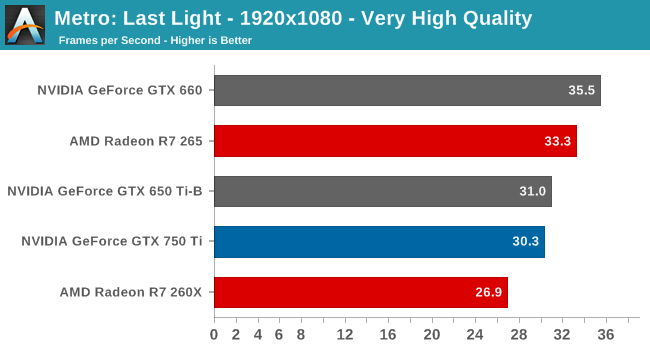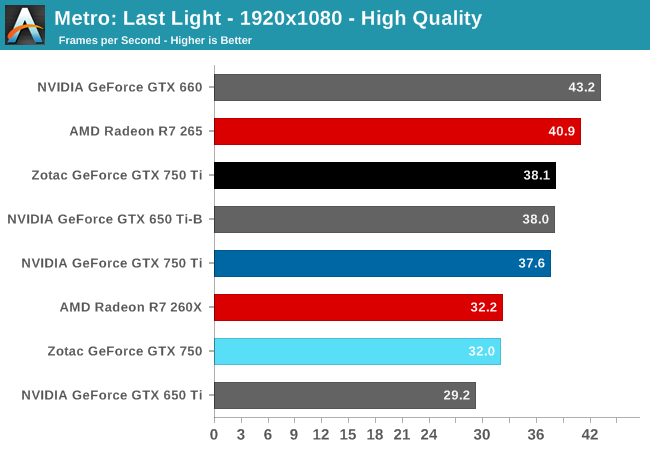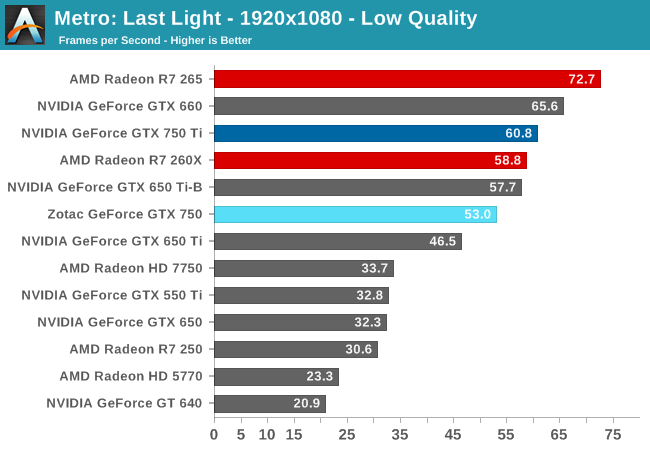The NVIDIA GeForce GTX 750 Ti and GTX 750 Review: Maxwell Makes Its Move
by Ryan Smith & Ganesh T S on February 18, 2014 9:00 AM ESTMetro: Last Light
As always, kicking off our look at performance is 4A Games’ latest entry in their Metro series of subterranean shooters, Metro: Last Light. The original Metro: 2033 was a graphically punishing game for its time and Metro: Last Light is in its own right too. On the other hand it scales well with resolution and quality settings, so it’s still playable on lower end hardware.



Diving into our performance analysis, we’ll be looking at a few different factors. On a competitive basis, the GTX 660 and the R7 265 are the GTX 750 Ti’s closest competitors. Though we’ll also want to compare it to GTX 650, so see what a GK107 versus GM107 matchup looks like. Meanwhile the GTX 750’s closest competitors will be the R7 260X, and to a lesser degree the GTX 650 Ti.
Being one of our more difficult games, Metro shows right off the bat that these mainstream video cards, no matter how fast they are, will face a difficult time. The GTX 750 Ti can stay comfortably above the 30fps at high quality, but the GTX 750 not so much.
What’s clear right off the bat two is two things. The first is that GTX 750 Ti, the GM107 flagship, is significantly faster than GTX 650, the GK107 flagship. GTX 750 Ti is just short of doubling GTX 650’s performance in this benchmark.
The second point is that neither GTX 750 series card is going to fare well against its AMD counterpart. Both the R7 265 and R7 260 are faster than the GeForce cards, and by over 10% at times.
Finally, GTX 750 Ti won’t be touching GTX 660 here. It’s close, but especially at higher quality settings the GTX 660 is pulling away. GTX 750 Ti can’t completely make up for the lack of memory bandwidth and ROP throughput.










177 Comments
View All Comments
MrSpadge - Tuesday, February 18, 2014 - link
To be fair GTX650Ti Boost consumes ~100 W in the real world. Still a huge improvement!NikosD - Tuesday, February 18, 2014 - link
Hello.I have a few questions regarding HTPC and video decoding.
Can we say that we a new video processor from Nvidia, a new name like VP6 or more like a VP5.x ?
How Nvidia is calling the new video decoder ?
Why don't you add a 4K60 fps clip in order to test soon to be released HDMI 2.0 output ?
If you run a benchmark using DXVA Checker between VP5 and VP6 (?) how much faster is VP6 in H.264 1080p, 4K clips ?
Thanks!
Ryan Smith - Thursday, February 20, 2014 - link
NVIDIA doesn't have a name for it; at least not one they're sharing with us.NikosD - Thursday, February 20, 2014 - link
Thanks.Is it possible to try a 4K60fps with Maxwell ?
I wonder if it can decode it in realtime...
Flunk - Tuesday, February 18, 2014 - link
I think these will be a lot more exciting in laptops. Even if they're no where near Nvidia's claimed 2x Kepler efficiency per watt. On the desktop it's not really that big a deal. The top-end chip will probably be ~40% faster than the 780TI but that will be a while.dylan522p - Tuesday, February 18, 2014 - link
the 880 will be much more powerful than the 780ti. More than 40% even. They could literally die shrink and throw a few more SMX's and the 40% would be achieved. I would imagine either they are gonna have a HUGE jump (80% +) or they are gonna do what they did with Kepler and release a 200W Sku that is about 50% faster and when 20nm yields are good enough have the 900 series come with 250W Skus.Kevin G - Tuesday, February 18, 2014 - link
Very impressive performance for its power consumption. I can see an underclocked version of this card coming with a passive cooler for HTPC solutions. Perhaps that'd be a hypothetical GT740? I'm surprised that nVidia hasn't launched a mobile version of this chip. It seems like it'd be ideal for midrange laptops that still have discrete graphics.I suspect that the extra overclocking headroom is in reserve for a potential rebrand to a GTX 800 series product. (Though a straight die shrink of this design to 20 nm would provide even more headroom for a GTX 800/900 card.) nVidia could have held back to keep it below the more expensive GTX 660.
Though ultimately I'm left wanting the bigger GM100 and GM104 chips. We're going to have to wait until 20 nm is ready but considering the jump Maxwell has provided in the low end of the market, I'm eager to see what it can do in the high end.
DanNeely - Tuesday, February 18, 2014 - link
ASUS has a 65W TDP GT 640 with a big 2 slot passive heat sink (GT640-DCSL-2GD3); with the 750 Ti only hitting 60W a passive version of it should be possible at near stock performance. I suspect the 740 will be a farther cut down 3 SMM model which might allow a single slot passive design.PhoenixEnigma - Tuesday, February 18, 2014 - link
Passive cooling was my first thought as well - I've been looking for something to replace the 6770 in my HTPC with, and I wanted something both faster and passively cooled. There are already passive 7750s on the market, and the numbers in Bench put the 750Ti at about 9W more than then 7750 under real world load, so a vanilla 750 with a passive cooler should be entirely possible. Even a 750Ti might be doable, but that could be pushing things a little far.evilspoons - Tuesday, February 18, 2014 - link
I need a new half-height HTPC card, my 2.5 year old Asus Radeon 6570 bit the dust last month (sparkly picture, one particular shade of grey turned random colours). If they can work out the kinks in this thing and underclock it a bit, it sounds like a good candidate.It feels like it's been a long time since anything new showed up in the half-height video card game.